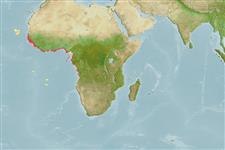Environment: milieu / climate zone / rango de profundidad / distribution range
Ecología
marino; agua dulce; salobre asociado a arrecife; rango de profundidad 0 - 50 m (Ref. 55). Tropical; 34°N - 17°S, 27°W - 14°E (Ref. 55)
Eastern Atlantic: west coast of Africa (Ref. 57393) from Senegal to Congo (Ref. 81653), primarily in the Gulf of Guinea and Cape Verde Islands (Ref. 57393, 81653).
Tamaño / Peso / Age
Madurez: Lm ? range ? - ? cm
Max length : 80.0 cm TL macho / no sexado; (Ref. 55); common length : 50.0 cm TL macho / no sexado; (Ref. 55)
Espinas dorsales (total) : 10; Radios blandos dorsales (total) : 14; Espinas anales: 3; Radios blandos anales: 8. Diagnosis: body stocky (Ref. 57393), relatively deep (Ref. 81653). Head pointed, dorsal profile of forehead abrupt/steep (Ref. 55, 57393, 81653). Eyes large (Ref. 81653). Preorbital/lachrymal bone (very) broad (Ref. 55, 81653). Maxilla extending to about mid-eye level (Ref. 55, 57393, 81653). Vomerine tooth plate triangular with a pronounced, long, postero-median extension (Ref. 57393, 81653). Pectoral fins of adult not reaching level of anus (Ref. 55, 81653). Scales medium-sized and ctenoid (Ref. 57393, 81653). Scale rows on back parallel to lateral line (Ref. 55, 57393, 81653), 5-7 rows below spinous part of dorsal fin (Ref. 57393, 81653). 5-6 transverse scale rows on cheek (Ref. 55, 57393, 81653). Presence of narrow blue band from snout to angle of opercle (Ref. 55, 57393, 81653) or a row of broken spots below eye (ref. 55). Small specimens from shallow water mainly brownish (Ref. 55).
Coloration: back vermilion red, becoming bright pink in large individuals and fading progressively to whitish on belly; blue subocular line, either continuous or fragmented, running from upper jaw to angle of opercle; juveniles more or less uniformly brownish (Ref. 57393).
Body shape (shape guide): fusiform / normal; Cross section: oval.
Adults occur on rocky bottoms and in the vicinity of coral reefs (Ref. 55, 57393, 81653). Young are frequently encountered in coastal waters, particularly estuaries and sometimes in lower courses of rivers (Ref. 2683, 57393, 81653). Voracious predator (Ref. 57393), feeds mainly on fishes and bottom-dwelling invertebrates (Ref. 55). Size of juveniles ranges from 7.90 to 19.99 cm in length (Ref. 111357).
Life cycle and mating behavior
Madurez | Reproducción | Puesta | Huevos | Fecundidad | Larva
Allen, G.R., 1985. FAO Species Catalogue. Vol. 6. Snappers of the world. An annotated and illustrated catalogue of lutjanid species known to date. FAO Fish. Synop. 125(6):208 p. Rome: FAO. (Ref. 55)
IUCN Red List Status (Ref. 130435: Version 2025-1)
Threat to humans
Harmless
Human uses
Pesquerías: escaso valor comercial
Herramientas
Special reports
Download XML
Fuentes de Internet
Estimates based on models
Preferred temperature (Referencia
123201): 23.7 - 28, mean 26.6 °C (based on 66 cells).
Phylogenetic diversity index (Referencia
82804): PD
50 = 0.5000 [Uniqueness, from 0.5 = low to 2.0 = high].
Bayesian length-weight: a=0.01549 (0.01013 - 0.02367), b=2.95 (2.83 - 3.07), in cm total length, based on LWR estimates for this species & Genus-body shape (Ref.
93245).
Nivel trófico (Referencia
69278): 4.0 ±0.59 se; based on food items.
Resiliencia (Referencia
120179): Bajo, población duplicada en un tiempo mínimo de 4.5-14 años (Preliminary K or Fecundity.).
Fishing Vulnerability (Ref.
59153): Moderate to high vulnerability (52 of 100).
🛈
Nutrients (Ref.
124155): Calcium = 24.3 [15.6, 34.7] mg/100g; Iron = 0.283 [0.182, 0.433] mg/100g; Protein = 18.9 [17.4, 20.2] %; Omega3 = 0.13 [0.09, 0.18] g/100g; Selenium = 60.8 [39.8, 89.5] μg/100g; VitaminA = 111 [20, 386] μg/100g; Zinc = 0.455 [0.363, 0.613] mg/100g (wet weight);
